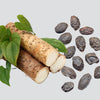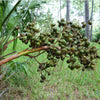
Charcoal, particularly activated charcoal, has emerged as a popular ingredient in the realm of skincare, celebrated for its purifying and detoxifying properties. Activated charcoal is charcoal that has been treated with oxygen, a process that makes it highly porous and thus more effective at capturing impurities. This unique characteristic has made it a sought-after addition to various skincare products, from masks and cleansers to scrubs, aiming to address a wide array of skin concerns.
One of the primary benefits of activated charcoal in skincare is its ability to draw out oil, dirt, and other impurities from the pores, contributing to a clearer and more refined complexion. This is particularly beneficial for those with oily or acne-prone skin, as the removal of these impurities can help to reduce the occurrence of breakouts and promote a healthier skin barrier. Additionally, its exfoliating properties can aid in removing dead skin cells, making the skin appear smoother and more radiant.
However, it's important to approach charcoal skincare products with mindfulness, especially for those with sensitive or dry skin types. While the absorbing properties of charcoal can be beneficial, they can also strip the skin of its natural oils if used too frequently, potentially leading to dryness and irritation. As with any skincare ingredient, it's crucial to pay attention to how your skin responds and adjust usage accordingly. Incorporating charcoal into your skincare routine, when used appropriately, can be a powerful way to maintain clean, healthy, and vibrant skin.
References
3.
Mowry JB, Spyker DA, Cantilena LR Jr., McMillan N, Ford M. 2013 Annual report of the American Association of Poison Control Centers‘ National Poison Data System (NPDS): 31st annual report. Clin Toxicol (Phila) 2014;52:1032–1283. [PMC free article] [PubMed] [Google Scholar]
7.
Schaper A, Bandemer G, Callies A, et al. Vorhaltung von Antidota im Notarztdienst [Die Bremer Antidota-Liste als Diskussionsgrundlage für eine minimale Vorhaltung von Antidota] Notarzt. 2012;28:114–118. [Google Scholar]
8.
Pfab R, Schmoll S, Dostal G, Stenzel J, Hapfelmeier A, Eyer F. Single dose activated charcoal for gut decontamination: application by medical non-professionals—a prospective study on availability and practicability. Toxicol Rep. 2016;4:49–54. [PMC free article] [PubMed] [Google Scholar]
9.
Chyka PA, Seger D. American Academy of Clinical Toxicology, European Association of Poisons Centres and Clinical Toxicologists: Position statement: single-dose activated charcoal. J Toxicol Clin Toxicol. 1997;35:721–741. [PubMed] [Google Scholar]
10.
Chyka PA, Seger D, Krenzelok EP, Vale JA. American Academy of Clinical Toxicology, European Association of Poisons Centres and Clinical Toxicologists: Position paper: single-dose activated charcoal. Clin Toxicol (Phila) 2005;43:61–87. [PubMed] [Google Scholar]
11.
American Academy of Clinical Toxicology, European Association of Poisons Centres and Clinical Toxicologists. Position statement and practice guidelines on the use of multi-dose activated charcoal in the treatment of acute poisoning. J Toxicol Clin Toxicol. 1999;37:731–751. [PubMed] [Google Scholar]
12.
de Silva HA, Fonseka MM, Pathmeswaran A, et al. Multiple-dose activated charcoal for treatment of yellow oleander poisoning: a single-blind, randomised, placebo-controlled trial. Lancet. 2003;361:1935–1938. [PubMed] [Google Scholar]
13.
Eyer P, Eyer F. Is this the epitaph for multiple-dose activated charcoal? Lancet. 2008;371:538–539. [PubMed] [Google Scholar]
14.
Eddleston M, Juszczak E, Buckley NA, et al. Multiple-dose activated charcoal in acute self-poisoning: a randomised controlled trial. Lancet. 2008;371:579–587. [PMC free article] [PubMed] [Google Scholar]
15.
Eyer F, Jung N, Neuberger H, et al. Seromucosal transport of intravenously administered carbamazepine is not enhanced by oral doses of activated charcoal in rats. Basic Clin Pharmacol Toxicol. 2008;102:337–346. [PubMed] [Google Scholar]
16.
Eyer F, Jung N, Neuberger H, et al. Enteral exsorption of acetaminophen after intravenous injection in rats: influence of activated charcoal on this clearance path. Basic Clin Pharmacol Toxicol. 2007;101:163–171. [PubMed] [Google Scholar]
17.
Watson WA. Factors influencing the clinical efficacy of activated charcoal. Drug Intell Clin Pharm. 1987;21:160–166. [PubMed] [Google Scholar]
18.
Andersen AH. Experimental studies on the pharmacology of activated charcoal; the effect of pH on the adsorption by charcoal from aqueous solutions. Acta Pharmacol Toxicol (Copenh) 1947;3:119–218. [PubMed] [Google Scholar]
19.
Jürgens G, Hoegberg LC, Graudal NA. The effect of activated charcoal on drug exposure in healthy volunteers: a meta-analysis. Clin Pharmacol Ther. 2009;85:501–505. [PubMed] [Google Scholar]
20.
Persson HE, Sjöberg GK, Haines JA, Pronczuk de Garbino J. Poisoning severity score: grading of acute poisoning. J Toxicol Clin Toxicol. 1998;36:205–213. [PubMed] [Google Scholar]
21.
Hoegberg LC, Angelo HR, Christophersen AB, Christensen HR. The effect of food and ice cream on the adsorption capacity of paracetamol to high surface activated charcoal: in vitro studies. Pharmacol Toxicol. 2003;93:233–237. [PubMed] [Google Scholar]
22.
Hoegberg LC, Christophersen AB, Christensen HR, Angelo HR. Comparison of the adsorption capacities of an activated-charcoal—yogurt mixture versus activated-charcoal—water slurry in vivo and in vitro. Clin Toxicol (Phila) 2005;43:269–275. [PubMed] [Google Scholar]
23.
Rangan C, Nordt SP, Hamilton R, Ingels M, Clark RF. Treatment of acetaminophen ingestion with a superactivated charcoal-cola mixture. Ann Emerg Med. 2001;37:55–58. [PubMed] [Google Scholar]
24.
Bonner AB. Does the addition of chocolate milk reduce the absorption capacity of orally administered activated charcoal for GI decontamination of acetaminophen ingestion? Clin Toxicol. 2005;43 [Google Scholar]
25.
Isbister GK, Friberg LE, Hackett LP, Duffull SB. Pharmacokinetics of quetiapine in overdose and the effect of activated charcoal. Clin Pharmacol Ther. 2007;81:821–827. [PubMed] [Google Scholar]
26.
Isbister GK, Friberg LE, Stokes B, et al. Activated charcoal decreases the risk of QT prolongation after citalopram overdose. Ann Emerg Med. 2007;50:593–600, e1-46. [PubMed] [Google Scholar]
27.
Spiller HA, Winter ML, Klein-Schwartz W, Bangh SA. Efficacy of activated charcoal administered more than four hours after acetaminophen overdose. J Emerg Med. 2006;30:1–5. [PubMed] [Google Scholar]
28.
Page CB, Duffull SB, Whyte IM, Isbister GK. Promethazine overdose: clinical effects, predicting delirium and the effect of charcoal. QJM. 2009;102:123–131. [PubMed] [Google Scholar]
30.
Keranen T, Sorri A, Moilanen E, Ylitalo P. Effects of charcoal on the absorption and elimination of the antiepileptic drugs lamotrigine and oxcarbazepine. Arzneimittelforschung. 2010;60:421–426. [PubMed] [Google Scholar]
31.
Friberg LE, Isbister GK, Hackett LP, Duffull SB. The population pharmacokinetics of citalopram after deliberate self-poisoning: a Bayesian approach. J Pharmacokinet Pharmacodyn. 2005;32:571–605. [PubMed] [Google Scholar]
32.
Kumar VV, Oscarsson S, Friberg LE, Isbister GK, Hackett LP, Duffull SB. The effect of decontamination procedures on the pharmacokinetics of venlafaxine in overdose. Clin Pharmacol Ther. 2009;86:403–410. [PubMed] [Google Scholar]
33.
Barceloux D, McGuigan M, Hartigan-Go K. Position statement: cathartics American Academy of Clinical Toxicology, European Association of Poisons Centres and Clinical Toxicologists. J Toxicol Clin Toxicol. 1997;35:743–752. [PubMed] [Google Scholar]
36.
Pollack MM, Dunbar BS, Holbrook PR, Fields AI. Aspiration of activated charcoal and gastric contents. Ann Emerg Med. 1981;10:528–529. [PubMed] [Google Scholar]
37.
Eckert K, Eyer P, Zilker T. [Activated charcoal—first aid treatment in oral poisoning] Dtsch Arztebl. 1999;96:A-2826–A-2830. [Google Scholar]
38.
Neuvonen PJ, Olkkola KT. Oral activated charcoal in the treatment of intoxications Role of single and repeated doses. Med Toxicol Adverse Drug Exp. 1988;3:33–58. [PubMed] [Google Scholar]
39.
Isbister GK, Kumar VV. Indications for single-dose activated charcoal administration in acute overdose. Curr Opin Crit Care. 2011;17:351–357. [PubMed] [Google Scholar]
E1.
Hojer J, Troutman WG, Hoppu K, et al. Position paper update: ipecac syrup for gastrointestinal decontamination. Clin Toxicol (Phila) 2013;51:134–139. [PubMed] [Google Scholar]
E2.
Benson BE, Hoppu K, Troutman WG, et al. Position paper update: gastric lavage for gastrointestinal decontamination. Clin Toxicol (Phila) 2013;51:140–146. [PubMed] [Google Scholar]
E3.
Merigian KS, Woodard M, Hedges JR, Roberts JR, Stuebing R, Rashkin MC. Prospective evaluation of gastric emptying in the self-poisoned patient. Am J Emerg Med. 1990;8:479–483. [PubMed] [Google Scholar]
E4.
Buckley NA, Whyte IM, O‘Connell DL, Dawson AH. Activated charcoal reduces the need for N-acetylcysteine treatment after acetaminophen (paracetamol) overdose. J Toxicol Clin Toxicol. 1999;37:753–757. [PubMed] [Google Scholar]
E6.
Chyka PA, Holley JE, Mandrell TD, Sugathan P. Correlation of drug pharmacokinetics and effectiveness of multiple-dose activated charcoal therapy. Ann Emerg Med. 1995;25:356–362. [PubMed] [Google Scholar]
E7.
Arimori K, Nakano M. Accelerated clearance of intravenously administered theophylline and phenobarbital by oral doses of activated charcoal in rats A possibility of the intestinal dialysis. J Pharmacobiodyn. 1986;9:437–441. [PubMed] [Google Scholar]
E8.
Neuvonen PJ, Elonen E. Effect of activated charcoal on absorption and elimination of phenobarbitone, carbamazepine and phenylbutazone in man. Eur J Clin Pharmacol. 1980;17:51–57. [PubMed] [Google Scholar]
E9.
Wason S, Baker RC, Carolan P, Seigel R, Druckenbrod RW. Carbamazepine overdose—the effects of multiple dose activated charcoal. J Toxicol Clin Toxicol. 1992;30:39–48. [PubMed] [Google Scholar]
-
Posted in
Antioxidant-Rich Chaga Skincare, Certified Organ, certified organic grass-fed beef tallow skincare, Certified organic skincare, certified organic suet, certified organic tallow, certified tallow skincare, Chaga Mushroom Benefits, Eco-Friendly Beauty Products, Grass-Fed Tallow Hydration, Holistic Skincare Regimen, Nourishing Tallow Formulas, Organic grass-fed tallow skincare








